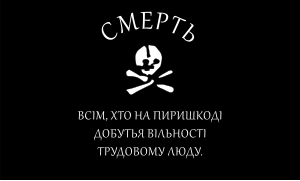Revolutionary Insurrectionary Army
| Revolutionary Insurrectionary Army of Ukraine | |
|---|---|
| Participant in the Russian Civil War and Ukrainian War of Independence | |
|
Army flag with motto: "Death to all who stand in the way of freedom for working people!"
|
|
| Active | 1918–1921 |
| Ideology |
Anarchism Anarchist communism Makhnovism |
| Leaders |
Nestor Makhno Simon Karetnik Fedir Shchus Viktor Belash |
| Area of operations | Present-day Ukraine, mostly Yekaterinoslav Governorate, especially Huliaipole; south-western oblasts of present-day Russia |
| Strength | 103,000 in December 1919 |
| Originated as | Black Guards |
| Allies | temporary agreements with (Red) Soviet Russia, (Red) Soviet Ukraine, (Red) Soviet Crimea, temporary cease-fire with the Directory, agreements with Antonov revolt |
| Opponents | Austro-Hungarian Occupation Forces, German Occupation Forces, Hetmanate, Directory, (White) Don Host, (White) Volunteer Army, (White) Armed Forces of South Russia, (Red) Soviet Russia, (Red) Soviet Ukraine, (Red) Soviet Crimea, Green Army, Selbstschutz |
| Battles and wars | Battle of Peregonovka (September 1919) |
The Revolutionary Insurrectionary Army of Ukraine (Ukrainian: Революційна Повстанська Армія України, Russian: Революционная Повстанческая Армия Украины", Revolyutsionnaya Povstancheskaya Armiya Ukrainy), popularly called Makhnovshchyna, less correctly Makhnovchina, and also known as the Black Army, was an anarchist army formed largely of Ukrainian peasants and workers under the command of the famous anarchist Nestor Makhno during the Russian Civil War. They protected the operation of "free soviets" and libertarian communes in the Free Territory, an attempt to form a stateless anarchist society from 1918 to 1921 during the Ukrainian Revolution.
Ukrainian anarchist guerrilla bands were active during the Russian Civil War. Some claimed to be loyal to the Ukrainian state, but others acknowledged no allegiance; all fought both Red and White Russians with equal ferocity in the opening stages of the Civil War. Of all the anarchist groups, the most famous and successful was that of the peasant anarchist leader Nestor Makhno, aka Batko ("Father"), who began operations in the southeastern Ukraine against the Hetmanate regime in July 1918. In September, he formed the Revolutionary Insurrectionary Army of Ukraine, or Anarchist Black Army, with arms and equipment largely obtained from retreating Austro-Hungarian and German forces. During the Civil War, the Black Army numbered between 15,000 and 110,000 men and was organized on conventional lines, with infantry, cavalry, and artillery units; artillery batteries were attached to each infantry brigade. Makhno's cavalry incorporated both regular and irregular (guerrilla) horse-mounted forces, and was considered among the best-trained and most capable of any of the cavalry units deployed by any side in the Russian Civil War. The Bolshevik government and Red Army commanders often referred to the Black Army as "Makhnovist forces", because they pointedly declined to accord the Ukrainian anarchists the status of having an army or a legitimate political movement. Volin described the Insurrectionary Black Army of the time (less its cavalry, which normally ranged far afield) as follows: The infantry, when it was not fighting, led the march of the army ... [The Black Army also used horse-drawn carts or] tachankas. Each of these vehicles, which were drawn by two horses, carried the driver on the front seat and two soldiers behind them. In some sections a machine-gun was installed on the seat between them. The artillery brought up the rear. A huge black flag floated over the first carriage. The slogans Liberty or Death and The Land to the Peasants, the Factories to the Workers were embroidered in silver on its two sides.
...
Wikipedia

